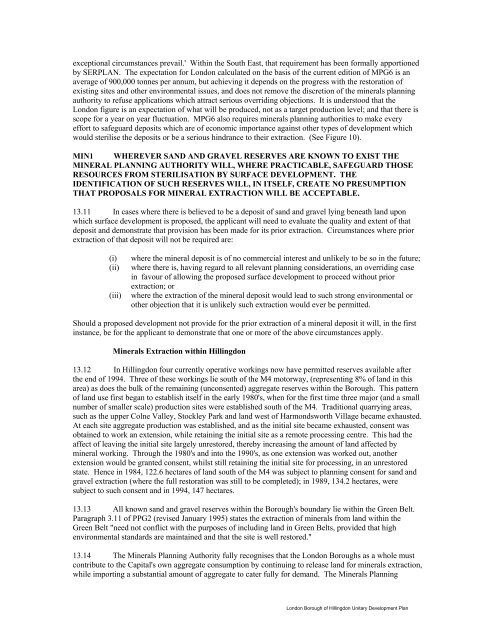HILLINGDON UNITARY DEVELOPMENT PLAN - London Borough ...
HILLINGDON UNITARY DEVELOPMENT PLAN - London Borough ...
HILLINGDON UNITARY DEVELOPMENT PLAN - London Borough ...
You also want an ePaper? Increase the reach of your titles
YUMPU automatically turns print PDFs into web optimized ePapers that Google loves.
exceptional circumstances prevail.' Within the South East, that requirement has been formally apportioned<br />
by SER<strong>PLAN</strong>. The expectation for <strong>London</strong> calculated on the basis of the current edition of MPG6 is an<br />
average of 900,000 tonnes per annum, but achieving it depends on the progress with the restoration of<br />
existing sites and other environmental issues, and does not remove the discretion of the minerals planning<br />
authority to refuse applications which attract serious overriding objections. It is understood that the<br />
<strong>London</strong> figure is an expectation of what will be produced, not as a target production level; and that there is<br />
scope for a year on year fluctuation. MPG6 also requires minerals planning authorities to make every<br />
effort to safeguard deposits which are of economic importance against other types of development which<br />
would sterilise the deposits or be a serious hindrance to their extraction. (See Figure 10).<br />
MIN1 WHEREVER SAND AND GRAVEL RESERVES ARE KNOWN TO EXIST THE<br />
MINERAL <strong>PLAN</strong>NING AUTHORITY WILL, WHERE PRACTICABLE, SAFEGUARD THOSE<br />
RESOURCES FROM STERILISATION BY SURFACE <strong>DEVELOPMENT</strong>. THE<br />
IDENTIFICATION OF SUCH RESERVES WILL, IN ITSELF, CREATE NO PRESUMPTION<br />
THAT PROPOSALS FOR MINERAL EXTRACTION WILL BE ACCEPTABLE.<br />
13.11 In cases where there is believed to be a deposit of sand and gravel lying beneath land upon<br />
which surface development is proposed, the applicant will need to evaluate the quality and extent of that<br />
deposit and demonstrate that provision has been made for its prior extraction. Circumstances where prior<br />
extraction of that deposit will not be required are:<br />
(i)<br />
(ii)<br />
(iii)<br />
where the mineral deposit is of no commercial interest and unlikely to be so in the future;<br />
where there is, having regard to all relevant planning considerations, an overriding case<br />
in favour of allowing the proposed surface development to proceed without prior<br />
extraction; or<br />
where the extraction of the mineral deposit would lead to such strong environmental or<br />
other objection that it is unlikely such extraction would ever be permitted.<br />
Should a proposed development not provide for the prior extraction of a mineral deposit it will, in the first<br />
instance, be for the applicant to demonstrate that one or more of the above circumstances apply.<br />
Minerals Extraction within Hillingdon<br />
13.12 In Hillingdon four currently operative workings now have permitted reserves available after<br />
the end of 1994. Three of these workings lie south of the M4 motorway, (representing 8% of land in this<br />
area) as does the bulk of the remaining (unconsented) aggregate reserves within the <strong>Borough</strong>. This pattern<br />
of land use first began to establish itself in the early 1980's, when for the first time three major (and a small<br />
number of smaller scale) production sites were established south of the M4. Traditional quarrying areas,<br />
such as the upper Colne Valley, Stockley Park and land west of Harmondsworth Village became exhausted.<br />
At each site aggregate production was established, and as the initial site became exhausted, consent was<br />
obtained to work an extension, while retaining the initial site as a remote processing centre. This had the<br />
affect of leaving the initial site largely unrestored, thereby increasing the amount of land affected by<br />
mineral working. Through the 1980's and into the 1990's, as one extension was worked out, another<br />
extension would be granted consent, whilst still retaining the initial site for processing, in an unrestored<br />
state. Hence in 1984, 122.6 hectares of land south of the M4 was subject to planning consent for sand and<br />
gravel extraction (where the full restoration was still to be completed); in 1989, 134.2 hectares, were<br />
subject to such consent and in 1994, 147 hectares.<br />
13.13 All known sand and gravel reserves within the <strong>Borough</strong>'s boundary lie within the Green Belt.<br />
Paragraph 3.11 of PPG2 (revised January 1995) states the extraction of minerals from land within the<br />
Green Belt "need not conflict with the purposes of including land in Green Belts, provided that high<br />
environmental standards are maintained and that the site is well restored."<br />
13.14 The Minerals Planning Authority fully recognises that the <strong>London</strong> <strong>Borough</strong>s as a whole must<br />
contribute to the Capital's own aggregate consumption by continuing to release land for minerals extraction,<br />
while importing a substantial amount of aggregate to cater fully for demand. The Minerals Planning<br />
<strong>London</strong> <strong>Borough</strong> of Hillingdon Unitary Development Plan
















